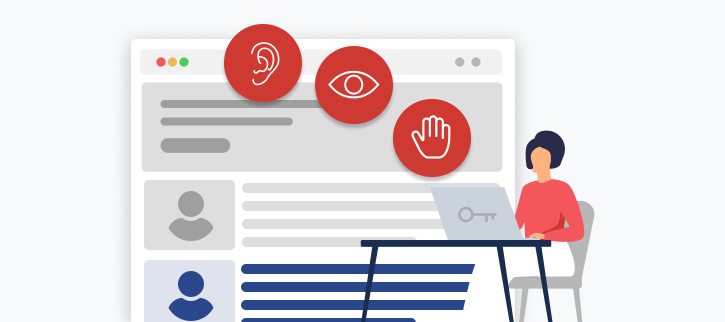On this page:
The term ‘web accessibility’ has been increasingly used over the years. But what exactly is it and why does it matter?
What is web accessibility?
The World Wide Web Consortium , which is an international community that develops web standards including those for accessibility, states that web accessibility is when “websites, tools, and technologies are designed and developed so that people with disabilities can use them. More specifically, people can: perceive, understand, navigate, and interact with the Web and contribute to the Web.” Essentially, accessibility is ensuring that all users have an equivalent experience when navigating a webpage.
The World Health Organization’s (WHO) World Report on estimates that more than a billion people (15% of the world’s population) live with some form of disability. Given this report was published in 2011, the figure may actually be higher. Additionally, the number of people with disabilities continues to grow as national populations grow older and global chronic health conditions, such as diabetes, increase.
Disabilities can be permanent or temporary. For example, someone may be born with low or no vision and not be able to see their computer screen well or someone may be born with a cognitive disability; these disabilities are permanent. However, there are cases when a disability is temporary, such as when a person breaks their arm or when their vision issues can be fixed with laser vision correction.
However, whether a disability is permanent or temporary, all users need the content and interactive elements on a site to be available and accessible so they can access information and services.
What are the standards?
There are two sets of that you can follow. One is the Web Content Accessibility Guidelines (WCAG) and the other is WCAG . WCAG 2.0, specifically WCAG 2.0 AA, is the current set of standards required by law in most countries. WCAG 2.1 builds on WCAG 2.0 and is focused more on mobile and responsive. Within each set of standards, there are three different levels:
- A
- AA
- AAA
| User impact | Time-based media example | Readable example | |
|---|---|---|---|
| Level A | Involves the smallest amount of implementation effort and has the lowest impact on the presentation and business logic on your site. | Captions are available for pre-recorded, synchronised media. | The language of the page can be programmatically determined. |
| Level AA | Has a high impact for users and makes a higher impact on the system’s presentation and business logic than Level A. Most businesses choose to focus on Level AA. | Live captions are available for synchronised media. | The language of certain pages or paragraphs, if different from the language of the page, can be programmatically determined. Exceptions are made for common phrases. |
| Level AAA | These changes are usually for very specific user populations and can be very difficult to adhere to. | Sign language interpretation is available for pre-recorded audio content. | There is a mechanism, such as a definition or link to an online dictionary, that identifies unusual words such as idioms or jargon. |
Salsa recommends following WCAG 2.1 AA guidelines, as WCAG 2.2 is currently in draft status and is expected to be released this year. It is imperative that we evaluate our sites against the most updated guidelines to provide an inclusive environment.
Why is accessibility important?
We often hear that accessibility isn’t as important as the other priorities on a program/project, or that it takes too much time to create an accessible site. Another common reason we hear for not incorporating accessibility into the project lifecycle is that “no one with a disability uses our site.” However, given the statistics cited in the What is web accessibility? section, there’s a high probability that someone with a disability, permanent or temporary, is using your site.
Unfortunately, we also often hear about accessibility because it’s the law, and website owners and creators are concerned about being sued. However, accessibility is so much more than a set of standards and guidelines.
An accessible site is sometimes the only way a user can perform a task. For example, if an Australian citizen visits a government website to find information on available services, but the page is not accessible, then a user may not be able to access vital services such as healthcare, jobs, payments or family support. If a supermarket website/app or clothing store site/app is not accessible, a disabled user may not be able to easily purchase food for the week or buy new clothing. These tasks are simple, everyday tasks for many of us but could be unavailable for some if accessible code is not in place.
By making websites and digital technologies accessible, we help those with auditory, visual, cognitive, motor and manual dexterity disabilities have an equivalent user experience to those without disabilities. We also deliver a consistent message and experience. By providing an accessible website we can build, and keep, a larger user base and drive innovation by thinking outside the box.



